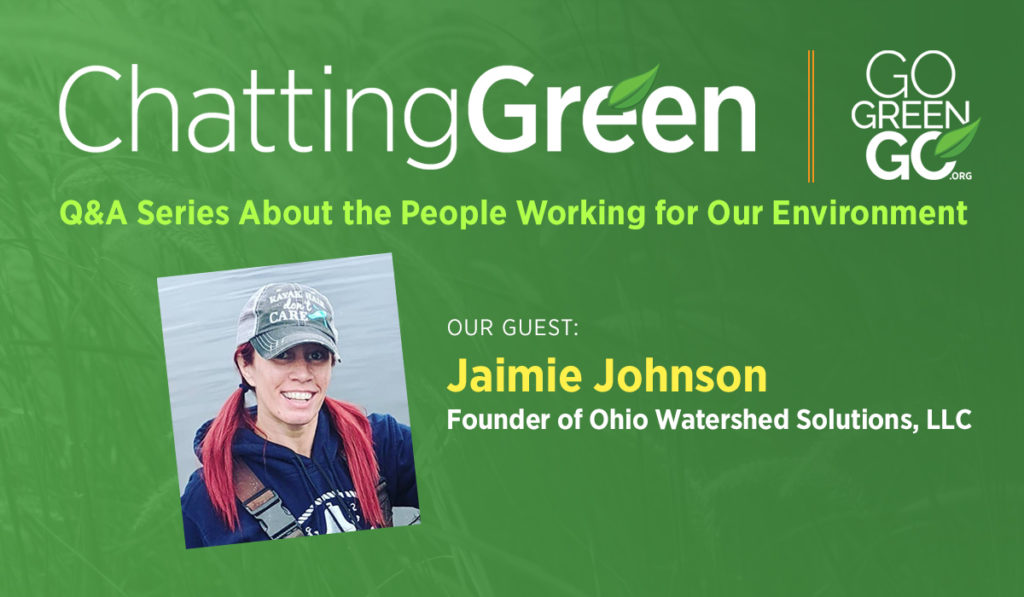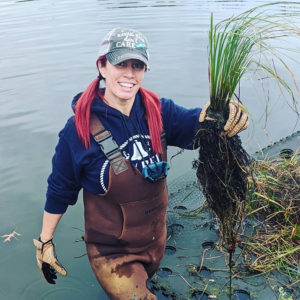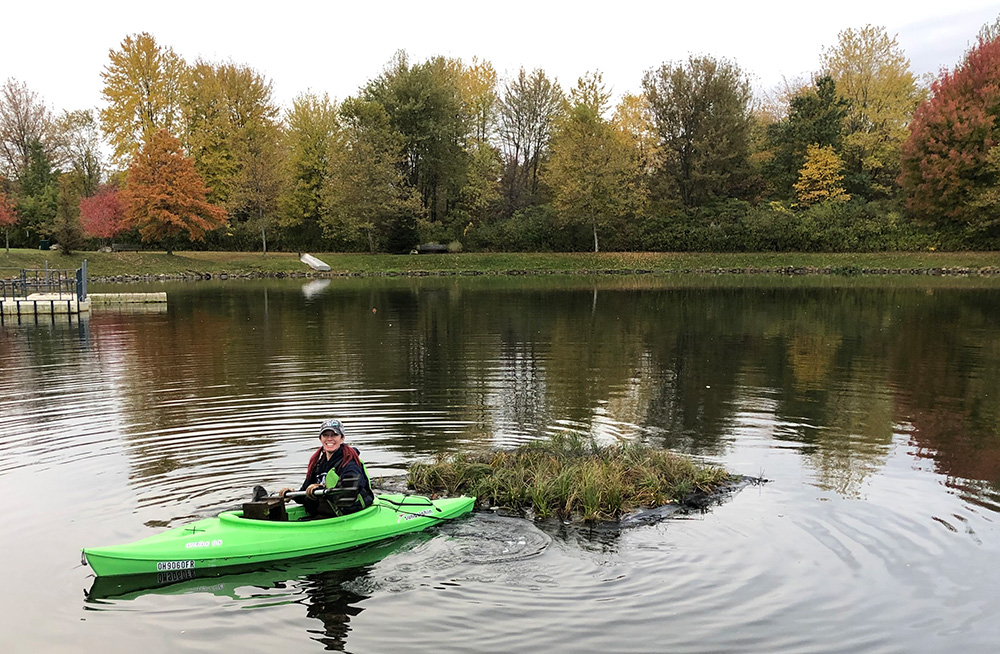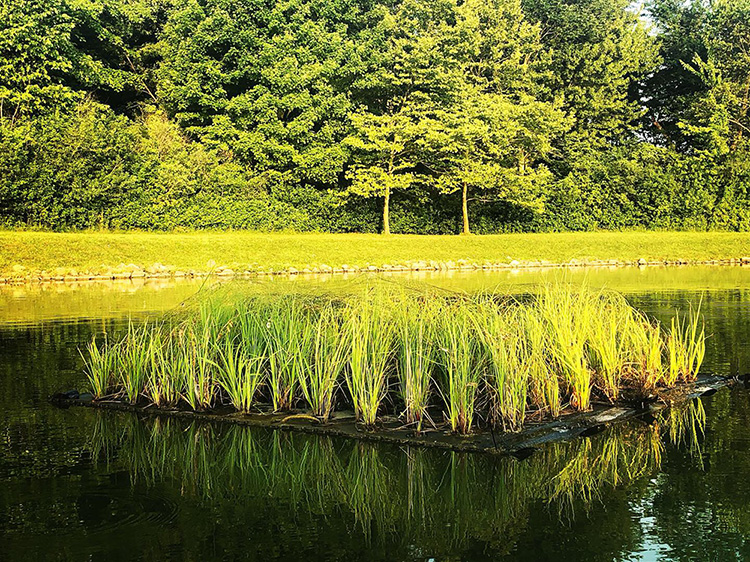Chatting Green with Jaimie Johnson of Ohio Watershed Solutions
- Chatting Green
-
Apr 05
- Share post

Jaimie Johnson changed careers to go back to school to become an aquatic biologist. She has since founded Ohio Watershed Solutions with the goal of creating natural, green infrastructure for healthier watersheds. This week she joins us for Chatting Green to tell us about her projects and how they make a positive impact on water quality and bio diversity.
…
Your company, Ohio Watershed Solutions creates “floating wetlands” that help improve water quality while also providing valuable animal habitat in lakes and ponds. Tell us more about how they work, and their benefits.
 Floating wetlands are small artificial platforms that allow aquatic emergent plants to grow in water that is typically too deep for them. Their roots grow down into the water creating dense columns of biomass with lots of surface area. Not only do the plants take up nutrients and contaminants themselves, but the plant roots and floating mat material provide extensive surface area for microbes to grow, forming a slimy layer of biofilm where nutrient uptake and degradation also occurs.
Floating wetlands are small artificial platforms that allow aquatic emergent plants to grow in water that is typically too deep for them. Their roots grow down into the water creating dense columns of biomass with lots of surface area. Not only do the plants take up nutrients and contaminants themselves, but the plant roots and floating mat material provide extensive surface area for microbes to grow, forming a slimy layer of biofilm where nutrient uptake and degradation also occurs.
The shelter provided by the floating mat allows sediment and elements to settle by reducing turbulence and mixing by wind and wave action. The unique ecosystem that develops creates the potential to capture nutrients and transform common pollutants that would otherwise plague and harm our lakes into harmless byproducts. Not only do floating wetlands treat and purify our fresh water supply, but they also create important habitat for fish and aquatic invertebrates by giving them cover, shade, and cooler water temperatures in an aquatic environment that would typically be comparable to a desert lacking vegetation and canopy cover.
Floating wetlands work in various freshwater systems such as stormwater ponds, wastewater lagoons, landfill leachate ponds, and other inland lakes and ponds. Floating wetlands become “nature’s kidneys” in environments that typically wouldn’t have a way to filter and purify our fresh water supply. Floating wetlands can be purchased from various companies and can last forever, or they can be built into biodegradable forms that are meant to degrade into the wetland while restoring the native seed bank.

Your installations have potential to draw in many species of wildlife. What’s something interesting or unexpected that you have observed at one of your floating wetlands?
I typically see birds, frogs, turtles and snakes enjoying the above water portion of the floating wetlands, while I see fish scurrying and splashing below the floating wetland. The most interesting thing I’ve found were the copious amounts of odonates (damselflies and dragonflies) living within the long, plentiful roots. As we were pulling plants from one mat and moving the plants to grow the rest of their lives at a restored wetland site, we found hundreds of odonates and other aquatic invertebrates living within the plant roots. I was shocked by this because I didn’t really expect to see many of these kinds of invertebrates because this particular floating wetland was in a desert in terms of aquatic life and habitat. But as the saying goes “if you build it, they will come.”

You are an aquatic biologist. Tell us a little about your background and your motivation or inspiration in creating this type of environmental solution?
I grew up in small town, Bay View, Ohio which is situated on the Sandusky Bay and surrounded by thousands of acres of beautiful wetlands and marsh lands. I think my upbringing played a large role of who I’ve grown in to as an adult. I was a dancer in my former life; starting at the age of 3 and then dancing professionally on cruise ships and in Las Vegas until I was 30 years. old. While I was living in Las Vegas I started my undergrad schooling originally in pre-med with plans to attend med school and to later work in an ER, and I promised myself that the ER I would hypothetically work at was situated somewhere on the water so I could later study aquatic biology. This was the point when I realized that I didn’t actually want to go to med school, so instead I started applying for graduate schools that had aquatic biology programs. It just so happened that I was accepted into Bowling Green State University in Ohio and I soon found myself back in the place I grew up.
After I finished graduate school I started working with Soil and Water Conservation Districts and quickly found my passion and the niche I wanted to situate myself in. When I look back on my days when I was preparing for med school I always knew I wanted to become a DO and study holistic medicine and practice ways of healing the body naturally and at a whole-systems level. So when I look at the work I do now, I think my current work is also rooted in a style of practice of healing the Earth in a natural and holistic way.

What are some of the challenges you see facing environmental progress in your work?
I think one of the biggest challenges people in this field face is educating the masses. Not many people know what floating wetlands are, or live willow stakes, or vegetated buffer strips, but spreading the word on these techniques and what they have to offer, not only to ourselves but to our environments is a really important undertaking. Likewise, I am not super concerned that education will be an issue because in the short amount of time that I’ve been working with floating wetlands, they’ve already made quite a splash in northern Ohio.
Ohio is covered with sensitive wetlands and watersheds, that are too often over-developed, over-polluted and under-appreciated. The Cuyahoga River, for example, has seen significant progress towards restoration. What can concerned individuals do, or avoid, to make the most positive impact on these important natural resources?
 A few simple things homeowners can do is to watch their practices inside and around their homes. Before using fertilizers, get a soil test to see what your soil is actually lacking, if anything. If using fertilizers, go organic! Same goes for cleaning supplies; there are really great recipes to create your own cleaners using vinegar and essential oils. All these fertilizers/pesticides/cleaners get flushed directly into our freshwater supply and if there isn’t a wetland nearby to treat this contaminated runoff, it goes directly to the lake that we all drink from, fish from or recreate in.
A few simple things homeowners can do is to watch their practices inside and around their homes. Before using fertilizers, get a soil test to see what your soil is actually lacking, if anything. If using fertilizers, go organic! Same goes for cleaning supplies; there are really great recipes to create your own cleaners using vinegar and essential oils. All these fertilizers/pesticides/cleaners get flushed directly into our freshwater supply and if there isn’t a wetland nearby to treat this contaminated runoff, it goes directly to the lake that we all drink from, fish from or recreate in.
Also, plant native! Native plants help to soften the impact of severe rain storms and contaminated runoff by soaking up that water and allowing it to infiltrate into the earth where it belongs.
People can also get involved. There are really great volunteer events, whether its cleaning up litter from a nearby stream or planting trees, all of these actions help make a better Lake Erie and a better environment overall.
